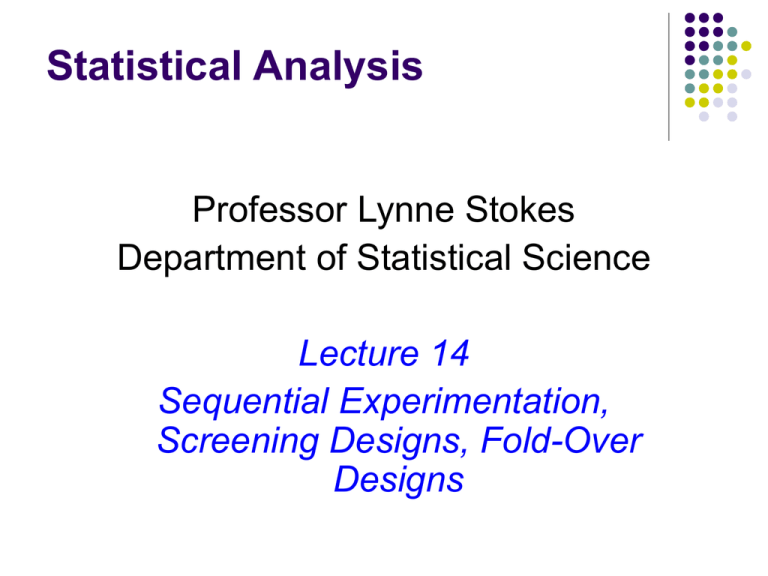Document
advertisement

Statistical Analysis Professor Lynne Stokes Department of Statistical Science Lecture 14 Sequential Experimentation, Screening Designs, Fold-Over Designs Don’t Risk all Experimental Resources on a Single Comprehensive Experiment •Usually many inert factors, few dominant ones •Unexpected effects may be found early •Experiment could be terminated early with substantial cost savings •Comprehensive evaluation of a few dominant factors is usually more informative than little information on many factors Conduct a Screening Experiment to Identify Dominant Factors Augment the Screening Experiment to Identify Strong Two-Factor Interactions Conduct a RV Experiment with the Dominant Factors Comprehensive Experiment with a Few Factors and Multiple Levels or Design to Quantitatively Characterize the Response Surface Figure 7.7 A simple strategy for a sequence of experiments. Sequential Experimentation Large experiments Design so that key fractions can be run in sequence Key fractions : Resolution III, IV, or V Analyze each sequence of data as it is completed Based on the results of the analysis Continue experiment Terminate Redesign with dominant/new factors Acid Plant Corrosion Study Factor Raw Material Feed Rate Gas Temperature Scrubber Water Reactor Bed Acid Exit Temperture Reactant Distribution Point Coded Level -1 +1 3,000pph 6,000pph 100oC 220oC 5% 20% 20% 30% 300oC 360oC East West Plant must cease commercial production during experimentation -- test runs must be minimized MGH Table 7.1 Screening Experiments Highly effective for isolating vital few strong effects should be used ONLY under the proper circumstances Very few test runs Ability to assess main effects only Generally leads to a comprehensive evaluation of a few dominant factors Potential for bias Plackett-Burman Screening Designs Any number of factors, each having 2 levels Interactions nonexistent or negligible Relative to main effects Number of test runs is a multiple of 4 At least 6 more test runs than factors should be used Construction Determine the number of factors (k) to be included in the design Determine the experiments size : at least k + 6 6df for error Select the design generator from Table 7A2 Generate the rows of the design Design generator is the first row Move all levels in the previous row one position to the left; move the first level of the previous row to the last position Continue the previous step until n - 1 rows are filled The last row has all levels equal to -1 Construction (con’t) Randomize Randomly Assign Factors to Columns; Delete Unassigned Columns Randomly Permute the Rows Acid Plant Corrosion Study Factor Raw Material Feed Rate Gas Temperature Scrubber Water Reactor Bed Acid Exit Temperture Reactant Distribution Point Coded Level -1 +1 3,000pph 6,000pph 100oC 220oC 5% 20% 20% 30% 300oC 360oC East West Seeking identification of dominant main effects Plackett-Burman Design : Corrosion Study k = 6 Factors n = 12 (Minimum Recommended) Design Generator Ru n No . A B C D E F G H I J K 1 1 1 -1 1 1 1 -1 -1 -1 1 -1 2 1 -1 1 1 1 -1 -1 -1 1 -1 1 3 -1 1 1 1 -1 -1 -1 1 -1 1 1 4 1 1 1 -1 -1 -1 1 -1 1 1 -1 5 1 1 -1 -1 -1 1 -1 1 1 -1 1 6 1 -1 -1 -1 1 -1 1 1 -1 1 1 7 -1 -1 -1 1 -1 1 1 -1 1 1 1 8 -1 -1 1 -1 1 1 -1 1 1 1 -1 9 -1 1 -1 1 1 -1 1 1 1 -1 -1 10 1 -1 1 1 -1 1 1 1 -1 -1 -1 11 -1 1 1 -1 1 1 1 -1 -1 -1 1 12 -1 -1 -1 -1 -1 -1 -1 -1 -1 -1 -1 Plackett-Burman Design : Corrosion Study k = 6 Factors n = 12 (Minimum Recommended) Ru n No . A B C D E F G H I J K 1 1 1 -1 1 1 1 -1 -1 -1 1 -1 2 1 -1 1 1 1 -1 -1 -1 1 -1 1 3 -1 1 1 1 -1 -1 -1 1 -1 1 1 4 1 1 1 -1 -1 -1 1 -1 1 1 -1 5 1 1 -1 -1 -1 1 -1 1 1 -1 1 6 1 -1 -1 -1 1 -1 1 1 -1 1 1 7 -1 -1 -1 1 -1 1 1 -1 1 1 1 8 -1 -1 1 -1 1 1 -1 1 1 1 -1 9 -1 1 -1 1 1 -1 1 1 1 -1 -1 10 1 -1 1 1 -1 1 1 1 -1 -1 -1 11 -1 1 1 -1 1 1 1 -1 -1 -1 1 12 -1 -1 -1 -1 -1 -1 -1 -1 -1 -1 -1 Plackett-Burman Design : Corrosion Study k = 6 Factors n = 12 (Minimum Recommended) Ru n No . A B C D E F G H I J K 1 1 1 -1 1 1 1 -1 -1 -1 1 -1 2 1 -1 1 1 1 -1 -1 -1 1 -1 1 3 -1 1 1 1 -1 -1 -1 1 -1 1 1 4 1 1 1 -1 -1 -1 1 -1 1 1 -1 5 1 1 -1 -1 -1 1 -1 1 1 -1 1 6 1 -1 -1 -1 1 -1 1 1 -1 1 1 7 -1 -1 -1 1 -1 1 1 -1 1 1 1 8 -1 -1 1 -1 1 1 -1 1 1 1 -1 9 -1 1 -1 1 1 -1 1 1 1 -1 -1 10 1 -1 1 1 -1 1 1 1 -1 -1 -1 11 -1 1 1 -1 1 1 1 -1 -1 -1 1 12 -1 -1 -1 -1 -1 -1 -1 -1 -1 -1 -1 Plackett-Burman Design : Corrosion Study k = 6 Factors n = 12 (Minimum Recommended) Ru n No . A B C D E F G H I J K 1 1 1 -1 1 1 1 -1 -1 -1 1 -1 2 1 -1 1 1 1 -1 -1 -1 1 -1 1 3 -1 1 1 1 -1 -1 -1 1 -1 1 1 4 1 1 1 -1 -1 -1 1 -1 1 1 -1 5 1 1 -1 -1 -1 1 -1 1 1 -1 1 6 1 -1 -1 -1 1 -1 1 1 -1 1 1 7 -1 -1 -1 1 -1 1 1 -1 1 1 1 8 -1 -1 1 -1 1 1 -1 1 1 1 -1 9 -1 1 -1 1 1 -1 1 1 1 -1 -1 10 1 -1 1 1 -1 1 1 1 -1 -1 -1 11 -1 1 1 -1 1 1 1 -1 -1 -1 1 12 -1 -1 -1 -1 -1 -1 -1 -1 -1 -1 -1 Plackett-Burman Design : Corrosion Study S cru b . Distn . Be d Ex it Gas Fe e d Ru n No . A W a te r C P o in t E Acid Te m p. Te m p. I J Ra te 1 1 1 -1 1 1 1 -1 -1 -1 1 -1 2 1 -1 1 1 1 -1 -1 -1 1 -1 1 3 -1 1 1 1 -1 -1 -1 1 -1 1 1 4 1 1 1 -1 -1 -1 1 -1 1 1 -1 5 1 1 -1 -1 -1 1 -1 1 1 -1 1 6 1 -1 -1 -1 1 -1 1 1 -1 1 1 7 -1 -1 -1 1 -1 1 1 -1 1 1 1 8 -1 -1 1 -1 1 1 -1 1 1 1 -1 9 -1 1 -1 1 1 -1 1 1 1 -1 -1 10 1 -1 1 1 -1 1 1 1 -1 -1 -1 11 -1 1 1 -1 1 1 1 -1 -1 -1 1 12 -1 -1 -1 -1 -1 -1 -1 -1 -1 -1 -1 Randomly assign factors to columns Plackett-Burman Design : Corrosion Study O ri g i n a l S c ru b . D i stn . Be d Ex i t Gas Fe e d Run No. W a te r P o in t Acid Te m p. Te m p. R a te 11 1 -1 1 1 -1 1 3 1 1 -1 -1 1 1 8 -1 -1 1 -1 1 -1 1 1 1 1 -1 -1 -1 4 1 -1 -1 1 -1 -1 12 -1 -1 -1 -1 -1 -1 6 -1 -1 -1 1 1 1 10 -1 1 1 1 1 -1 7 -1 1 1 1 -1 1 5 1 -1 1 -1 1 1 2 -1 1 -1 -1 -1 1 9 1 1 -1 1 1 -1 Eliminate unassigned columns randomly permute rows Plackett-Burman Design : Corrosion Study O ri g i n a l S c ru b . D i stn . Be d Ex i t Gas Fe e d Run No. W a te r P o in t Acid Te m p. Te m p. R a te 11 20 E as t 30 360 100 6000 3 20 W es t 20 300 220 6000 8 5 E as t 30 300 220 3000 1 20 W es t 30 300 100 3000 4 20 E as t 20 360 100 3000 12 5 E as t 20 300 100 3000 6 5 E as t 20 360 220 6000 10 5 W es t 30 360 220 3000 7 5 W es t 30 360 100 6000 5 20 E as t 30 300 220 6000 2 5 W es t 20 300 100 6000 9 20 W es t 20 360 220 3000 Resolution III Human Performance Testing Response Eye Focus Time (ms) Predictors (A) Acuity or Sharpness of Vision (B) Distance from Eye to Target (C) Target Shape 2 Levels Each (D) Illumination Level (E) Target Size (F) Target Density (G) Subject Only a few effects anticipated, no interactions Design Considerations Complete factorial : 27 + repeats = 128 + repeats Very few effects expected, no interactions Solution Fractional Factorial RIII Human Performance Testing Design: 7 4 2 III n=8 Defining Equation I = ABD = ACE = BCF = ABCG Added Factors D = AB , E = AC , F = BC , G = ABC Implicit Equations 24 - 4 - 1 = 11 Human Performance Testing Complete Defining Relation I = ABD = ACE = BCF = ABCG = BCDE = ACDF = CDG = ABEF = BEG = AFG = DEF = ADEG Implicit Contrasts = CEFG = BDFG = ABCDEFG Human Performance Testing Complete Defining Relation I = ABD = ACE = BCF = ABCG = BCDE = ACDF = CDG = ABEF = BEG = AFG = DEF = ADEG Implicit Contrasts = CEFG = BDFG = ABCDEFG Main-Effect Aliases A = BD = CE = FG B = AD = CF = EG C = AE = BF = DG D = AB = CG = EF E = AC = BG = DF F = BC = AG = DE G = CD = BE = AF Assuming No 3fi Human Performance Testing Complete Defining Relation I = ABD = ACE = BCF = ABCG = BCDE = ACDF = CDG = ABEF = BEG = AFG = DEF = ADEG Implicit Contrasts = CEFG = BDFG = ABCDEFG Main-Effect Aliases A + BD + CE + FG B + AD + CF + EG C + AE + BF + DG D + AB + CG + EF E + AC + BG + DF F + BC + AG + DE G + CD + BE + AF Alternative Interpretation of Aliasing: Each Measured Effect is the Sum of Four Effects Human Performance Testing Run A B C 1 -1 -1 -1 +1 +1 +1 -1 85.5 2 +1 -1 -1 -1 -1 +1 +1 75.1 3 -1 +1 -1 -1 +1 -1 +1 93.2 4 +1 +1 -1 +1 -1 -1 -1 145.4 5 -1 -1 +1 +1 -1 -1 +1 83.7 6 +1 -1 +1 -1 +1 -1 -1 77.6 7 -1 +1 +1 -1 -1 +1 -1 95.0 8 +1 +1 +1 +1 +1 +1 +1 141.8 -.28 28.88 -.28 -.63 -2.43 Effects 20.63 38.38 D=AB E=AC F=BC G=ABC Time Human Performance Testing Conclusions A, B, and D are the primary factors that affect eye focus times Human Performance Testing Conclusions A, B, and D are the primary factors that affect eye focus times Key Main-Effect Aliases A = BD B = AD D = AB Could the primary effects be only two factors and their interaction ? Human Performance Testing Fold-Over Design: 7 4 2 III Reverse the signs on all levels of all factors in the design Defining Equation I = -ABD = -ACE = -BCF = -ABCG Added Factors -D = AB , -E = AC , -F = BC , -G = ABC Human Performance Testing: Fold-Over Design Run A B C 1 +1 +1 +1 -1 -1 -1 +1 91.3 2 -1 +1 +1 +1 +1 -1 -1 136.7 3 +1 -1 +1 +1 -1 +1 -1 82.4 4 -1 -1 +1 -1 +1 +1 +1 73.4 5 +1 +1 -1 -1 +1 +1 -1 94.1 6 -1 +1 -1 +1 -1 +1 +1 143.8 7 +1 -1 -1 +1 +1 -1 +1 87.3 8 -1 -1 -1 -1 -1 -1 -1 71.9 29.88 .53 1.63 2.68 Effects -17.68 37.73 -3.33 D=-AB E=-AC F=-BC G=-ABC Time Human Performance Testing: Fold-Over Design Combined Effects: Original Design A + BD + CE + FG Fold-Over Design A - BD - CE - FG Average A Difference/2 BD + CE + FG Conclusion: Reversing ALL signs in a second fraction unaliases ALL main effects from two-factor interactions (still assumes higher-order interactions are negligible) Human Performance Testing: Fold-Over Design n = 16 Contrasts Average Difference / 2 A A= 1.48 BD+CE+FG= 19.15 B B= 38.05 AD+CF+EG= C C= -1.80 AE+BF+DG= 1.53 D D= 29.38 AB+CG+EF= E E= .13 AC+BG+DF= -.40 F F= .50 BC+AG+DE= -1.53 G G= .13 Original Design: D = AB .33 -.50 CD+BE+AF= -2.55 Conclusions ? Fold-Over Designs Reverse the signs on one or more factors Run a second fraction with the sign reversals Use the confounding pattern of the original and the fold-over design to determine the alias structure Averages Half-Differences Human Performance Testing Complete Defining Relation Reversing the Signs on B I = -ABD = ACE = -BCF = -ABCG = -BCDE = ACDF = CDG = -ABEF = -BEG = AFG = DEF = ADEG = CEFG = -BDFG = -ABCDEFG Main-Effect Aliases A - BD + CE + FG -B + AD + CF + EG C + AE - BF + DG D - AB + CG + EF E + AC - BG + DF F - BC + AG + DE G + CD - BE + AF Human Performance Testing: Fold-Over Design Combined Effects: Original Design A + BD + CE + FG Fold-Over Design A - BD + CE + FG Average A + CE + FG Difference/2 BD Similar With All Main Effects Except B Original Design B + AD + CF + EG Fold-Over Design -B + AD + CF + EG Average AD + CE + FG Difference/2 B Conclusion: Reversing the signs on ONE factor in a second fraction unaliases its main effect and ALL its two-factor interactions







